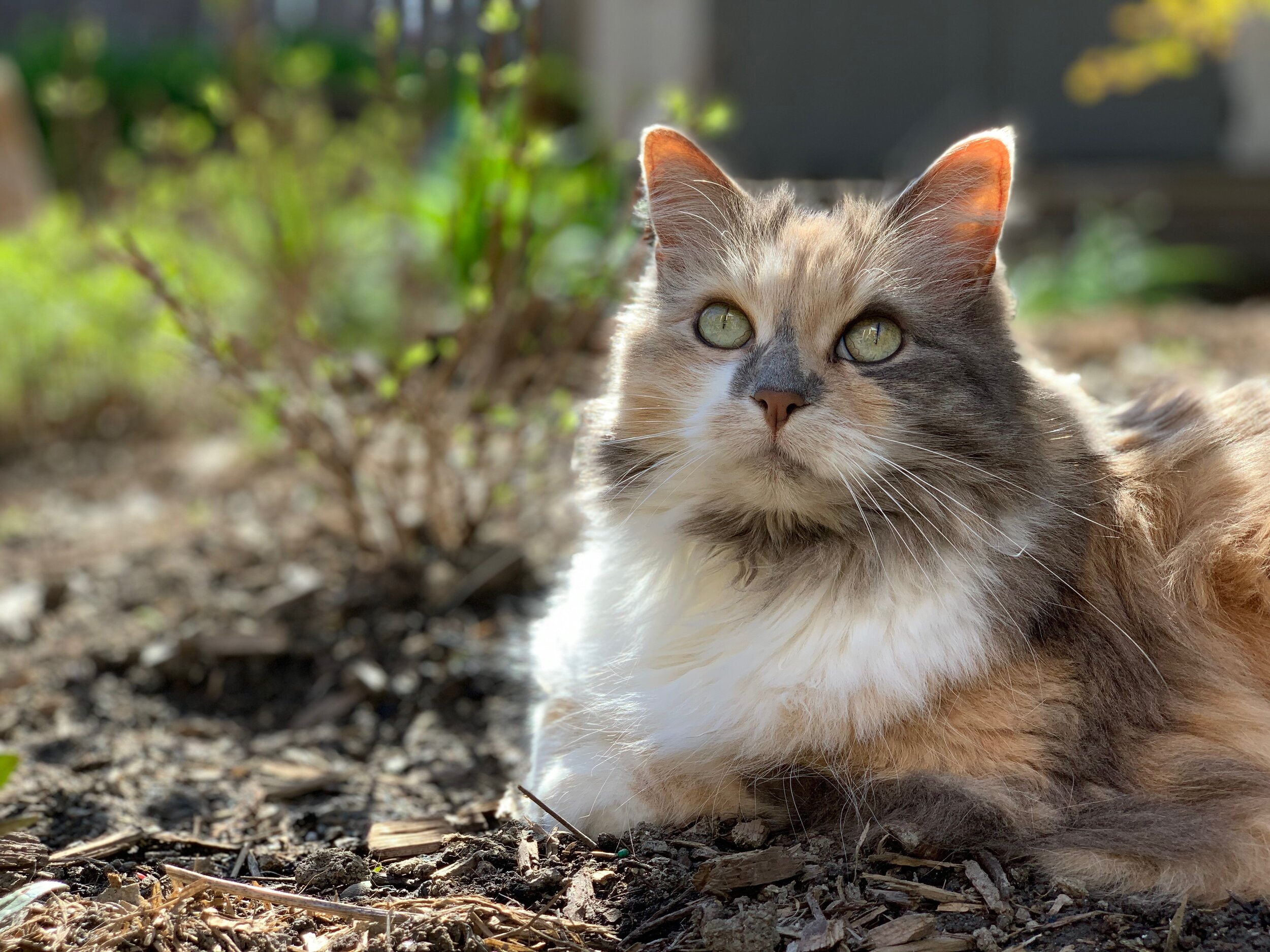ROXY. Art Group Mascot.
Sharing a little story about pet therapy… a companion blog story to Mel’s piece; “Percy. Therapy Dog”,
“The smallest feline is a masterpiece.”
Roxy. Rescue. Mascot. Inspiration.
Who knew wee Roxy would have such a story? From street rescue to mascot, from inspiration to muse to thesis companion to diva, she has had many roles including a brief yet enduring role as a therapy cat. However, Roxy being a fickle feline, the training or experiences did not stick! Although she did not blossom into a full time therapy cat, these moments were brief, impactful and very memorable.
After gaining permission and meeting the needed requirements for pet visits, I was able to bring Roxy some afternoons to visit one of my long-term care open-studio art groups. I had shared stories of my new addition and many of the group members had such fond memories of cats in their own lives. Often a recurring topic of conversation in our group, cat stories became a way to reminisce and connect with happy memories and a creative means to explore and generate art from personal narratives.
I had already witnessed the benefits and beauty of pet visits in long-term care, however I did not realize the impact that my particular wee four-legged friend would have on many of the art group members, nor the lasting inspiration she would provide for them in the weeks, months and years to follow. Within that first visit, she became an honorary group member, affectionately called ‘Roxy the Art -Group Mascot’.
“When dogs and cats visit a long-term care home with their handlers for pet therapy programs, residents often develop a connection with the animal that remains after the session has ended”
Roxy was in the fearless-kitten stage during those first few visits, and happily and willingly revelled in all the attention given to her. With future visits and as she aged, Roxy became a little less easy going in her manner. She was growing wary of any creatures of the two-legged variety that crossed her path, a common development with some cats I have learned, and she was more content with her limited human indoor bubble at home.
Although not initiating the moments or wanting to explore like when she was younger, I did notice that if Roxy was comfortably snuggled in my arms (her familiar person) she would willingly let anyone in the group pet her. She sensed the group members’ warmth, caring natures and interest as we walked around the table and interacted with each of them. She would then settle into her carrier and calmly watch as the group created art.
Roxy always received the group members’ hands, and the varied styles of pats, and never reacted or recoiled from anyone’s touch. It was amazingly beautiful to witness those meaningful interactions, and the joy it gave each of the group members who engaged with her.
Although her visits were infrequent, most group members happily chatted about her on a regular basis and proudly told visitors that our art group had a mascot named ‘Roxy’, pointing out the cat art that was often up on display in the studio space.
During a couple of these afternoons, I also provided 1:1 bedside visits with Roxy after the main art group and witnessed yet again the beautiful interactions between human and feline, and just how cooperative Roxy became during this time - sensing both the residents’ interest, care and vulnerabilities during these meaningful interactions. Witnessing the smiles, giggles and arms reaching out was unbelievably heartwarming, and I felt so honoured to be there and share in those joyful moments.
“This animal/human love bond is demonstrated every day in millions of homes around the world. It is also the basis for what is becoming a powerful, common mode of therapy in many long-term health care facilities.”
Recent Roxy…
R.I.P. My Sweet Roxy Rescue… AKA My Thesis Girl… and Art Therapy Mascot • 2007-2025.
‘The Pet-Effect’.
The benefits of pet therapy in congregate and long-term care settings are described below. From the article; ‘For Better Mental Health, Experience the Pet Effect’. ( Habri • Human Animal Bond Research Institute)
“The Pet Effect, also known as the human-animal bond, is the mutually beneficial relationship between people and animals that positively impacts the health and well-being of both.
Specifically, pets and therapy animals can help alleviate stress, anxiety, depression, and feelings of loneliness and social isolation.”
Psychology Today Blog Post: Do Pets Really Help Our Mental Health? by Kaytee Gillis, LCSW-BACS. 2021.
Articles Referenced in the Psychology Today Post:
• Roxanne D. Hawkins, Emma L. Hawkins & Liesbeth Tip (2021) “I Can’t Give Up When I Have Them to Care for”: People’s Experiences of Pets and Their Mental Health, Anthrozoös, 34:4, 543-562, DOI: 10.1080/08927936.2021.1914434. Accessed 01/27/2022
• Martin F, Bachert KE, Snow L, Tu H-W, Belahbib J, Lyn SA (2021) Depression, anxiety, and happiness in dog owners and potential dog owners during the COVID-19 pandemic in the United States. PLoS ONE 16(12): . Accessed 01/27/2022.
Oscar the Cat Keeps Coming Home to Comfort Patients at a Halifax Hospice. Retrieved from www.cbc.ca news-nova scotia. 2022
Note: Consent to share art sample collage above.















